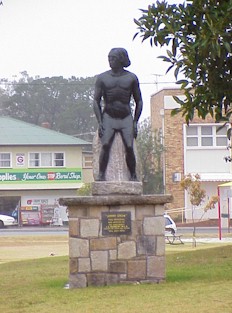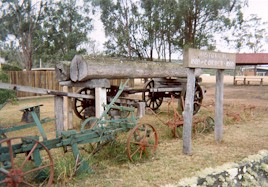| The story of Crow's Nest goes
back to early Aboriginal times and any written history of these times is very sketchy or
almost non-existent. The Archaeology Branch of the Q’ld Dept. of Community Services
states, 'The local tribe that used to occupy the area around Crow’s Nest was called
Jarowair'. Twidale’s Aboriginal Tribes of Australia shows the Garumga, a small tribe
of the Dalla in the Crow’s nest area as well as along the Brisbane Valley and the
South Burnett. In 1841 the MacDonalds came down the Cunningham Gap track from northern N.S.W. and took up the Dugandan Run at Boonah. In 1848 Campbell MacDonald left Dugandan and travelled to Perseverance and took up a pastoral lease. He subsequently followed a native track up the Range and added Crow's Nest to his holding. In many areas the Aboriginals had definite tracks over the ranges to take them to tribal gatherings, in this case it was the feasts of the Bunya Nuts. This beaten track up the range to Crow’s Nest was in the Wakka dialect, Dumba-Kunga- Mi- "Dumba" a beaten path, "Kunga" a mountain range, "Mi" means at – full meaning therefore is a beaten path at the mountain range. (1)After MacDonald, Pearce took over and he was followed by R. Tooth. The legend of how Crow’s Nest got its name is the one of a local Aboriginal who lived in a gunyah made of a hollow tree near the Bullocky’s Rest Park and where the bullock drivers would gather to rest on their journeys loaded and unloaded with timber. Following the rapid growth of settlement at "The Swamp" Toowoomba in 1850’s, the demand for timber grew and timber mills spread north along the Highfield’s Range. Townships grew to service the timber mill workers and in the 1860’s we saw the development of Highfields, Cabarlah, Geham, Pechey, Perseverance, Pipeclay, Ravensbourne and Hampton in the 1870’s and the 1880’s. In the wake of the sawmillers came the selectors, who spread in all directions, Meringandan, Kleinton, Haden Pinelands, Ravensbourne, Anduramba and the Bluff. Because of unpaid rental on the Tooth lease it was forfeited to the Crown and proclaimed open to selection in 1875. Of the first fourteen selectors, seven were Cornishmen. On applying to have a school in the area, the settlers were told that seven families weren’t enough, but on being told that they had almost 70 children between them the School was opened in 1877. The township of Crow’s Nest developed around Albert and South Streets, but with the coming of the railway the town centre moved further north to where it is today. Dairying was one of the district’s main industries and the produce was sent to Crow’s Nest Butter Factory. After the Butter Factory closed and cream had to be conveyed to first Goombungee and then Oakey, dairying dwindled. It was good-bye to party lines and local telephone exchanges, cream carters and much of the small areas’ community life, schools closing, churches going, sports facilities moving and a general collapse of country district living. Rae McGreevy
|
Jimmy Crow
Old farm and logging tools in Crow's Nest. |




